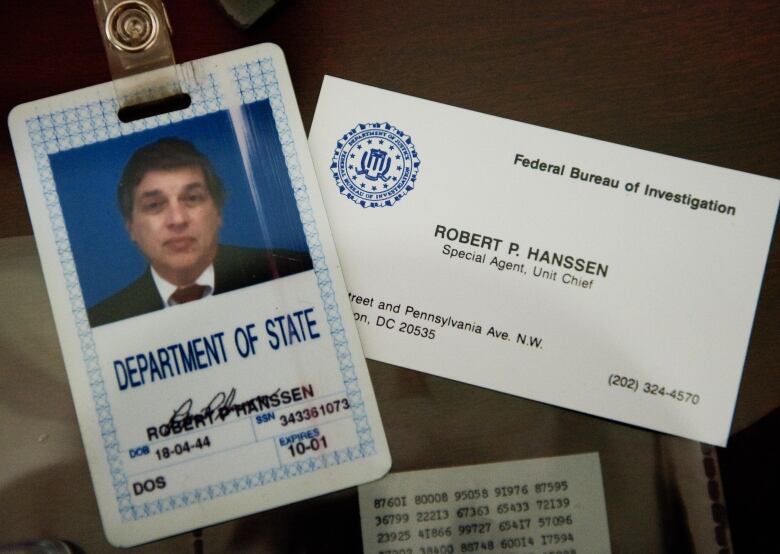Why some aging spies won't walk out of U.S. prisons, long after the Cold War
Harshest punishments for those whose actions cost lives and badly jeopardized security, analysts say

AldrichAmes wasdone selling secrets, but the unravelling of his treachery had just begun.
On Feb. 21, 1994, the bespectacled, Jaguar-driving, Central Intelligence Agency lifer, with a cash-purchasedhome in a Washington suburb, was arrested and charged with espionage.
By that point, the CIA knew it'd been a mistake to have had Ames running the Soviet branch of itscounter-intelligence divisionin the mid-1980s as Moscow had since paid him more than $2 million US to pass onsensitive information, including the names of people secretly working for U.S. intelligencebehind the Iron Curtain.
Twomonths later, Ames would pleadguilty to espionage charges and receive a life sentence for what aU.S. attorney called"the most damaging spy case" in Americanhistory.
Thirty years on, Ames remains in custody at age 82. The U.S. Bureau of Prisons website lists his release date as "life."
Analysts with knowledge of the U.S. intelligence worldsay the fallout from these kinds of stinging betrayals can jeopardize national security,damageintelligence-gathering operations, and put lives at risk all factors that can weigh intodetermining why somespies, such as Ames,stay locked up indefinitely in U.S. prisons.
"The reason that Ames is going to die in prison is that his betrayal led directly to the deaths of the dozen or so Soviet and Soviet bloc recruited foreign agents that had worked for the United States going back to the 1960s," said journalist Tim Weiner, co-author ofBetrayal: The Story of Aldrich Ames, an American Spy.
Aging spies, frozen lives
Spies condemned to harshsentences occasionally see a change in their circumstances via spy swaps.
Theserare and politically sensitivemanoeuvres,involving negotiations at the highest levels of government,have seen caught-and-captured spies freed such as when the U.S. letSoviet spy Rudolf Abel out justa few years into a 45-year sentencein order to bringcaptured spy-plane pilot Francis Gary Powers back in 1962.
ButWeinerdoesn't seeatrade coming for the octogenarianAmes.
"There is no American spy that Moscow ever caught who is anywhere near a fair exchange for that," said Weiner.
Seven years after Ames's downfall, another American counter-intelligence agent was caught being paid to give U.S. secrets to Moscow.

In February 2001, Robert Hanssen, a 25-year FBI veteran,was arrested and charged with espionage. He died in prisonlast yearat age 79, while serving a life sentence.
In exchange for a mix ofdiamonds and cash, Hanssen gave up valuableAmerican secrets to Moscow including names of people working for the U.S., some of whomAmes had separately disclosed.
Former FBI operative Eric O'Neill helped gatherinformation that helped prove Hanssen's culpability, including by gaining physical access to the soon-to-be-busted spy's Palm Pilot.

O'Neillsaid the veteran FBI agent's espionage activities involved a mix of old-school tradecraft, as well as more modern methods and technologyto access,steal and transmitvaluable information allegedly including U.S.continuity of government plans in the event of war with Russia.
Hanssen would eventually admit to years of spying, and his co-operation with investigatorshelped spare him the death penalty.
"Hanssen was the bridge [between those eras of espionage]," said O'Neill, who views him as one of the earliest known cyber spies. For Weiner, the Ames and Hanssen betrayals were without "real precedent" in the history of U.S. intelligence hence the harsh sentences for both.
O'Neill concurs: "There are no two spies that did as much damage to Western intelligence services."
Eventual freedom for some
There are Americans who were caught passing on U.S. secrets, served their time and later left prison.
Christopher Boyce leaked secrets to the Sovietswhile working at a defence contractor firmin the mid-1970s.He received a 40-yearsentence, later broke out of jail, spent 19 months on the runrobbing banks along the wayand was recaptured. Even so, he was released on parolein 2003.
Jonathan Pollard, a former civilian intelligence analyst for the U.S. Navy, got a life sentence forspying for Israel a U.S. ally in the '80s. However, he was freedin 2015,after extensivelobbying by Israeli officials.
Rosario Ames, the wife of Aldrich Ames,was convicted in the same case involving her husband, but received a lesser sentence. The U.S. Bureau of Prisons says shewas released in 1998.
Ana Beln Montes, a U.S. Defence Intelligence Agency analyst who spiedfor Cuba, was released from prisonin January 2023 more than 21 years after her initialarrest.

At the time of her sentencing, TheWashington Post reported that Montes had revealed the identities of "at least four U.S. covert officers working in Cuba," though"her disclosures did not result in the deaths of any U.S. agents."
While some may question why spies who sell secrets thenreceive less-than-life sentences, O'Neill sees minimal distinction between the two outcomes.
"What's the real difference between 25 years and life?" said O'Neill.
Aloke Chakravarty spent nearly two decades as a prosecutor, working for both the FBI and the U.S. Department of Justice along the way as well as forthe United Nations International Criminal Tribunal for the former Yugoslavia.
Well-versed in national security-related cases, including those involving espionage, Chakravartysays there are a few key elements that shape how strongly the transgressions are viewed.These include the motivation for the spying, the level of privileged access to information andthe extent of the damage done to national security.
In the end, Chakravartysaid judges have discretion when handing down a final sentence, though he noted "it's hard to have mitigating factors in the context of an espionage case."
The need to know
The Cold War mayhave ended, but there are still significant tensions betweenRussia and the U.S. the nearly two-year-oldwar in Ukraine being just one current source of discord.
Chakravarty said that context the relationship between two countries on opposite ends of an espionage episodetends to factor in to how damaging a particular case is viewed as being, at a given time.
"I think there is a small-p political component for any national security-related crime," said Chakravarty, who said that stems, in, part from the fact that circumstances can change over timein the relationship between nations.

Yet three decades after the fall of the Berlin Wall, Washington and Moscow still have a need to know what's going on around the globe.
Weiner points to the run-up to Russia's invasion of Ukraine, in which theU.S. loudly warned that an attackwas looming.
"It did so with absolute clarity," said Weiner, noting that message collided with skepticism in some corners about Washington's record on intelligence matters.
The U.S. forecast was proven correct, drawing upon hard information that Weiner said would have come from spies.














_(720p).jpg)


 OFFICIAL HD MUSIC VIDEO.jpg)
.jpg)



























































































